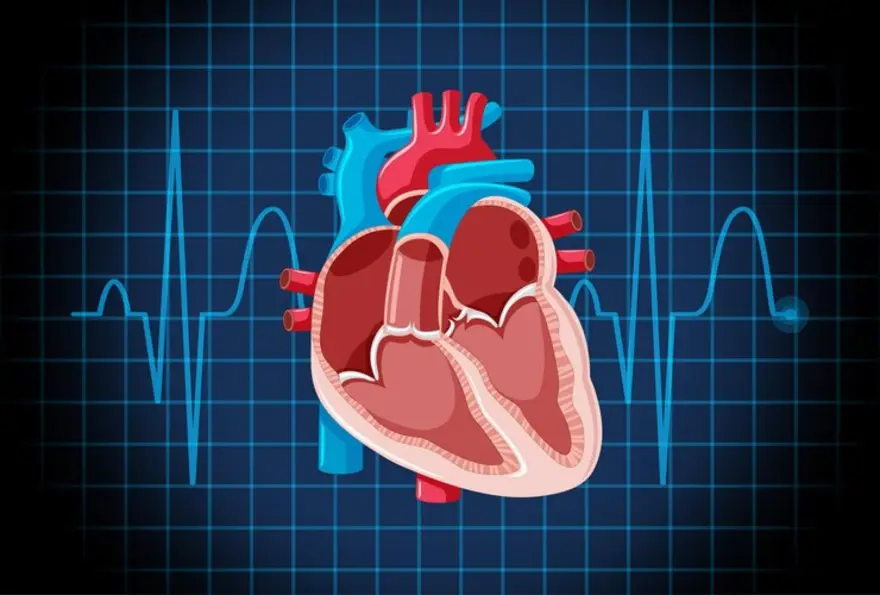Latest Blogs
Understanding Tetralogy of Fallot (TOF): Symptoms, Treatment & Causes
Tetralogy Of Fallot (TOF) is a rare congenital heart defect. TOF develops when a baby's heart fails to develop normally during pregnancy. It is important for you to know about this condition and understand its causes, potential complications and treatment options. So let's delve deeper into the biology of tetralogy of fallot to get a better understanding. What is Tetralogy of Fallot? Tetralogy of Fallot is a congenital (present since birth) heart defect characterised by four anatomical abnormalities in a heart. This condition affects blood flow to lungs and your body. Four abnormalities of tetralogy of Fallot Tetralogy of Fallot involves four main heart problems: Ventricular Septal Defect: A hole between your heart's lower chambers. Pulmonary Stenosis: Narrowing of the valve controlling blood flow to your lungs. Overriding Aorta: The aorta, which carries oxygen-rich blood, is shifted toward your right ventricle. Right Ventricular Hypertrophy: Thickening of your heart's right lower chamber. What are the Symptoms of Tetralogy of Fallot? Some of the common tetralogy of fallot symptoms are: Cyanosis (bluish tint to the skin, lips, and nails) Shortness of breath, especially during feeding Rapid breathing Poor weight gain and growth Clubbing of fingers and toes due to chronic lack of oxygen Tet spells Tet spells are sudden episodes of worsened cyanosis and breathlessness in a tetralogy of fallot baby (2-6 months age). They occur when the narrowing of the pulmonary artery suddenly restricts blood flow to the lungs. These spells can be triggered by crying, feeding, dehydration or waking up from a nap and require immediate medical attention. Other Tetralogy of Fallot Symptoms and Signs Some other tetralogy of fallot symptoms include: Difficulty feeding or excessive fussiness during feeding Heart murmur detected during a physical examination of tetralogy of fallot Developmental delays or failure to meet developmental milestones Increased risk of infections, particularly respiratory infections, due to reduced oxygen levels in the blood Tetralogy of Fallot symptoms in Adults The symptoms of tetralogy of fallot in adults may include: Fatigue and breathlessness during physical activity Fainting spells (syncope) Cyanosis may worsen over time Heart palpitations or irregular heartbeats is a common tetralogy of fallot symptom in adults What are the Complications of Tetralogy of Fallot? The complications of tetralogy of fallot may include: Arrhythmias: Irregular heart rhythms due to structural abnormalities associated with tetralogy of fallot. Heart failure: Weakening of your heart muscle over time is a common complication associated with tetralogy of fallot. Infective endocarditis: Bacterial infection of your heart's inner lining. Delayed growth and development: Due to chronic oxygen deficiency caused by tetralogy of fallot. Pulmonary hypertension: Increased blood pressure in your lungs. Stroke: Increased risk due to blood clots or arrhythmias. Paradoxical embolism: Blood clots traveling from your veins to your arteries through a hole in your heart. Neurological complications: Such as developmental delay, seizures, brain abscess etc. What Causes Tetralogy of Fallot? The exact tetralogy of fallot causes are often unknown, but several factors may be involved. For instance: Genetic factors: Mutations in certain genes can increase the risk of tetralogy of fallot. These genes may include NKX2-5, GATA 4, CITED 2 etc. Environmental factors: Exposure to certain environmental toxins, such as chemicals or pollutants, during pregnancy could potentially disrupt normal heart development and increase the risk of tetralogy of fallot. Additionally, maternal infections, particularly during the first trimester, have been linked to a higher incidence of congenital heart defects. Maternal factors: Poor maternal nutrition, inadequate prenatal care, maternal diabetes, and substance abuse (including alcohol and drugs) during pregnancy can influence foetal development and increase the risk of tetralogy of fallot. Chromosomal abnormalities: Conditions involving chromosomal abnormalities, such as Down syndrome (Trisomy 21), are associated with a higher prevalence of congenital heart defects, including tetralogy of fallot. These chromosomal anomalies disrupt normal foetal development, including cardiac formation. How is Tetralogy of Fallot Diagnosed? The diagnosis of tetralogy of fallot is done through a combination of physical examination, imaging tests like echocardiography, blood tests and sometimes genetic testing to determine if certain mutations are associated with tetralogy of fallot. Tests before birth Prenatal screening tests like foetal echocardiography can detect tetralogy of fallot. Foetal echocardiography allows visualisation of the foetal heart to identify structural abnormalities, including tetralogy of fallot. Maternal blood tests, such as Maternal Serum Alpha-Fetoprotein (MSAFP), may indicate an increased risk of congenital heart defects, including tetralogy of fallot. Tests in infancy Newborn screening: Routine physical examination after birth may detect signs suggestive of Tetralogy of Fallot. Echocardiogram: This specialised ultrasound of the heart confirms tetralogy of fallot diagnosis by visualising structural abnormalities. Electrocardiogram (ECG): Detects abnormal heart rhythms or patterns suggestive of tetralogy of fallot. Chest X-ray: Helps assess heart size and lung congestion caused by tetralogy of fallot. Oxygen saturation monitoring: Measures the level of oxygen in the blood, aiding in assessing the severity of cyanosis. Genetic testing: Identifies underlying genetic mutations associated with tetralogy of fallot, especially in syndromic cases. Tests in Childhood or Adulthood In addition to the above tests, other tests for tetralogy of fallot for children and adults include Exercise stress testing: Evaluates heart function during physical activity with the help of an ECG stress test machine, assessing exercise tolerance and identifying any limitations caused by tetralogy of fallot. Cardiac MRI or CT scan: Provides detailed imaging of your heart and blood vessels, aiding in assessment of tetralogy of fallot and planning for potential interventions. How is Tetralogy of Fallot Treated? TOF treatment depends on its severity and may involve: Surgical repair: Complete repair for tetralogy of fallot typically involves closing the ventricular septal defect, relieving pulmonary stenosis, and repositioning the aorta. This is usually performed in infancy. Palliative procedures: Temporary tetralogy of fallot surgery may be needed to improve blood flow to your lungs before complete repair, such as a shunt placement. Medications: Drugs may be prescribed to manage symptoms of tetralogy of fallot, prevent complications, or prepare for surgery in TOF treatment. These may include prostaglandins, diuretics, anticoagulants etc. What are the Risk Factors of Tetralogy of Fallot? Some of the factors that makes one vulnerable to tetralogy of fallot are: Family history( if present in parent or sibling) Poor maternal nutrition during pregnancy Exposure to toxins or viral infections during pregnancy Older maternal age increases the risk of tetralogy of fallot How Can I Reduce my Risk? There are several ways by which you can reduce your risk of tetralogy of fallot: Keep blood sugar levels under control before and during pregnancy Avoid exposure to infections of any kind and fully treat your tetralogy of fallot if you have it. Discuss genetic counselling if you have a family history of tetralogy of fallot or other congenital heart defects Follow prenatal care guidelines and consult with doctors regularly What Can I Expect if I Have Tetralogy of Fallot? If you have Tetralogy of Fallot and have undergone treatment for complete repair of the heart, you can expect to do any daily activity that is done by a normal healthy human with a normal life expectancy, provided you regularly keep an eye on your heart health and manage symptoms associated with tetralogy of fallot. If you leave it untreated, you might face cardiovascular problems throughout your life and it can impact the survival rate. Conclusion Tetralogy of fallot is a congenital heart defect that requires lifelong management. Although it presents unique challenges, tetralogy of fallot can be effectively managed with early diagnosis, appropriate medical care, and surgical interventions. If your family has a history of congenital heart defects, consider getting a blood test done to check for tetralogy of fallot in your baby. Metropolis Healthcare is at your service with hassle-free, reliable and comprehensive blood test facilities, both at home and within our advanced labs. Book your test today!
Understanding Tourette Syndrome: Symptoms, Treatment & Causes
What is Tourette syndrome? Tourette Syndrome (TS) is a neurological condition characterised by repetitive movements or involuntary sounds known as tics. Tourette syndrome symptoms arise as sudden twitches, movements, or vocalisations that individuals experience uncontrollably. These tics can significantly impact their daily lives. How common is Tourette syndrome? Tourette syndrome, a prevalent neurodevelopmental disorder, impacts approximately 1 per cent of the population around the world. Is Tourette’s the only tic disorder? No, Tourette syndrome is not the only tic disorder. Other recognised tic disorders are:- Persistent (Chronic) Motor or Vocal Tic Disorder: Involves motor or vocal tics that last over a year, but not both. Provisional Tic Disorder: Characterised by one or more motor or vocal tics lasting less than a year. Other Specified Tic Disorder: This is applied when symptoms do not meet a specific tic disorder criteria but still cause distress or impairment. Unspecified Tic Disorder: This is used when symptoms do not align with any specific Tic disorder or when adequate information is lacking for a precise diagnosis. What are the symptoms of Tourette syndrome? The primary Tourette syndrome symptom is tics, which can vary in severity from mild and hardly noticeable to frequent and conspicuous. Factors like stress, excitement, illness, or fatigue can exacerbate them. Severe tics may impact social interactions or work performance. There are two types of Tourette syndrome symptoms: Motor tics involve physical movements, such as arm or head jerking, blinking, facial expressions, shoulder shrugging, or mouth twitching. Vocal tics encompass sounds or verbalisations, including barking, throat clearing, coughing, grunting, echolalia (repeating others' words), shouting, sniffing, or swearing. Tics can be categorised as simple, affecting only one or a few body parts like eye blinking or facial expressions, or complex Tourette syndrome symptoms like coordinated movements or vocalisations. What causes Tourette syndrome? Although the exact Tourette syndrome causes remain unknown, studies indicate that disruptions in neural communication within specific brain regions and imbalances in neurotransmitters, which relay nerve signals, may contribute to its onset. Tourette syndrome may also result from gene alterations inherited from parents or occurring during prenatal development. What are the risk factors for Tourette syndrome? Risk factors for Tourette syndrome: Genetic predisposition: Family history increases susceptibility Gender: Males are more commonly affected Age of onset: Symptoms typically emerge in childhood or adolescence. Prenatal and perinatal influences: Complications during pregnancy or childbirth may heighten the risk. Neurological co-morbidities: Conditions like ADHD or OCD often coexist. Environmental exposures: Toxins or stressors during critical brain development periods can contribute. Immune system involvement: Dysfunctions or abnormalities may play a role. How is Tourette syndrome diagnosed? Diagnosing Tourette syndrome typically involves a comprehensive assessment by a healthcare professional. While there is no specific test for Tourette syndrome, diagnosis is based on clinical evaluation and criteria established by medical guidelines, which may include: Medical History: The healthcare provider will review the individual's medical history, including symptoms, family history of tic disorders, and any other relevant medical conditions or medications. Physical Examination: A physical examination may be conducted to rule out other medical conditions that could be causing the symptoms. Diagnostic Criteria: Tourette syndrome is diagnosed based on specific diagnostic criteria, which typically include the presence of both motor and vocal tics, frequent tics lasting over a year, starting before the age of 18, and not being caused by medications, substances, or other medical conditions. Tics must also evolve in location, frequency, or severity. Exclusion of Other Conditions: The healthcare provider may order additional tests, such as blood tests or imaging studies like MRI scans, to rule out other medical conditions that could be causing the symptoms. Consultation with Specialists: In some cases, consultation with specialists such as neurologists or psychiatrists may be recommended to confirm the diagnosis and develop a comprehensive Tourette syndrome treatment plan. What is the treatment for Tourette syndrome? Tourette syndrome has no cure, but Tourette syndrome treatment aims to manage disruptive tics. The options include: Medication: Dopamine-blocking medicines may control tics, although with possible side effects. Botulinum injections can ease specific tics, like motor and phonic. Attention deficit hyperactivity disorder (ADHD) meds might aid focus, but they can worsen tics in some cases. Central adrenergic inhibitors (adrenaline controllers) or antidepressants may help manage behavioural and emotional symptoms. Antiseizure meds may be effective for some. Tourette syndrome therapies: Behaviour therapy, such as Cognitive Behavioural Interventions for Tics, can help monitor and manage tics. Psychotherapy addresses associated issues like ADHD, OCD, or anxiety. Deep brain stimulation (DBS) is an effective Tourette syndrome therapy option for severe, treatment-resistant tics, but it is still under research to determine safety and efficacy. How can medication help Tourette syndrome? Medication addresses Tourette syndrome symptoms by balancing brain neurotransmitters, notably dopamine: Dopamine blockers (e.g., haloperidol, risperidone) reduce tics by blocking dopamine receptors. Stimulant ADHD meds (e.g., methylphenidate) enhance focus but may exacerbate tics. Central adrenergic inhibitors (e.g., clonidine) manage behavioural symptoms such as impulse control and rage. SSRIs (Serotonin reuptake inhibitors) like fluoxetine help with sadness, anxiety, and OCD, often linked with Tourette syndrome. Antiseizure meds like topiramate can also lessen tic severity. Medication aims to improve symptoms and quality of life. It is tailored to each individual's needs and side-effect tolerance. How can behavioural therapy help Tourette Syndrome? Behavioural therapy, like Cognitive Behavioural Interventions for Tics (CBIT), aids Tourette syndrome management by teaching tic monitoring, habit-reversal training (HRT), and relaxation techniques to reduce tic frequency and severity. It increases awareness, offers environmental modifications, and provides education and support to empower individuals and their families in coping with Tourette syndrome challenges effectively. Combined with medication and other treatments, it forms a comprehensive approach to improve tic control and overall quality of life. Conclusion Tourette syndrome poses challenges for those affected, impacting daily life with its characteristic tics and associated symptoms. Lately, understanding and management of TS have improved significantly. While no cure exists, various treatments aim to relieve symptoms and enhance quality of life. Medications offer relief, although with potential side effects. While behavioural therapies empower individuals to manage tics effectively, deep brain stimulation has shown promise in severe cases. For an accurate diagnosis, book your consultation, MRI and blood tests at Metropolis Labs and contact your doctor for immediate treatment. Schedule your tests today.
Understanding Whiplash: Symptoms, Treatment & Causes
What is Whiplash? Whiplash is caused by a sudden, forceful back-and-forth movement of the neck, often resembling the motion of a whip cracking. Whiplash results in injury to the neck muscles, disks, nerves, and tendons. Who does whiplash affect? Whiplash injury can impact individuals of any age, but it tends to be more severe among older adults and women. Individuals over the age of 65 years are at a higher risk of muscle and bone injuries due to whiplash. Additionally, women are twice as likely as men to suffer from whiplash. This is due to differences in neck muscle strength, neck anatomy, hormonal influences, and occupational or behavioural factors. Moreover, people with pre-existing neck conditions like arthritis are more likely to get a whiplash injury. What are the symptoms of whiplash? While in some cases of whiplash injuries, individuals may exhibit no symptoms, in others, severe whiplash symptoms may manifest. Some identifiable indications are: Pain can usually occur within 6 to 12 hours of the injury and gradually worsen over the next few days, along with swelling and bruising. Other common whiplash symptoms include stiffness, swelling, or tenderness, along with difficulty moving the neck. Muscle spasms, weakness, sensations like 'pins and needles', and numbness in the arms, hands, or shoulders may also be signs of whiplash. Trouble concentrating and headaches from whiplash injury are also common indicators. Additionally, dizziness, vertigo, tinnitus or ringing ears, swallowing difficulties, or blurred vision might occur. What causes whiplash? Whiplash strains neck muscles due to sudden backward and forward movement, leading to stretching and tearing of tendons and ligaments. Possible whiplash causes include: Motor vehicle accidents Physical abuse, like being struck or shaken Participation in contact sports such as football, boxing, and certain martial arts Horseback riding Collisions or falls while cycling Falls resulting in violent backward jerking of the head Impact on the head with a heavy object How is whiplash diagnosed? Your healthcare provider will inquire about the incident and your symptoms, assessing the whiplash causes and severity. They may also ask how frequently you get whiplash. Some common tests to diagnose the seriousness of whiplash include: Evaluation of your ability to perform daily tasks Physical manipulation of your head, neck, and arms to assess: Range of motion in your neck and shoulders Movements that cause pain or worsen it Tenderness in your neck, shoulders, or back due to whiplash Reflexes, strength, and sensation in your limbs Imaging tests like CT scans and MRIs to rule out other conditions like whiplash injury to the cervical spine that may cause neurological damage. What tests will be done to diagnose whiplash? In addition to a thorough health history and physical examination, diagnostic tests for whiplash may include: X-ray: Utilising electromagnetic energy beams to capture images of internal tissues, bones, and organs around the neck and shoulders. However, many whiplash injuries involve soft tissue damage which may not visible on X-rays MRI (Magnetic Resonance Imaging): Generating detailed images of neck and soft tissue structures using large magnets and a computer to determine whiplash damage CT scan (Computed Tomography): Combining X-rays and computer technology to produce detailed images of various body parts, including bones, muscles and fat in the neck region. CT scans offer higher detail than conventional X-rays to confirm whiplash. What are the treatments for whiplash? Whiplash treatments are tailored to the extent of the injury and include medications, pain management, and physical therapies. Pain management options for whiplash are: Rest (limited to a day or two to avoid hindrance to healing) Application of heat or cold pack to the neck Over-the-counter whiplash pain relievers like acetaminophen or ibuprofen Prescription medications or muscle relaxants, especially in cases of severe nerve pain Numbing shots like lidocaine for targeted pain relief The exercise regimen for whiplash is usually gentle and easy, like: Neck rotation, tilting, bending, and shoulder rolling Stretching and movement exercises prescribed by a healthcare professional Physical therapy addresses ongoing pain or range-of-motion issues in whiplash, focusing on muscle strengthening, posture improvement, and movement restoration. Transcutaneous electrical nerve stimulation (TENS) can also be used as whiplash treatment by relieving pain in the neck using mild electric current Alternative treatments for whiplash are acupuncture, chiropractic care, massage, or mind-body therapies like yoga and tai chi. How can I reduce my risk or prevent whiplash? You can minimize the risk of whiplash injury by adopting the following measures: While driving or riding in a vehicle, ensure that your seat belts are correctly adjusted Ensure that the car headrests are aligned to the middle and as close to the back of your head as possible, minimising whiplash on sudden collision To reduce the risk of whiplash, drive safely by maintaining a safe following distance and avoiding abrupt stops or acceleration. Wear appropriate protective clothing during sports or activities where there is a risk of neck injury, especially whiplash Strengthen neck muscles with gentle exercises recommended by a healthcare provider Consider utilizing head and neck support systems during high-impact activities like horseback riding or cycling to avoid whiplash. How long does whiplash last? The majority of individuals with whiplash, particularly those with milder cases, can recover within a few days to a few weeks. However, for more severe instances of whiplash, the healing process may extend over 4 weeks or even 2-3 months. What is the outlook for whiplash? Recovery from whiplash can be unpredictable and varies greatly. While some may experience improvement within weeks or months, for others, it can persist for a year or longer. Extended periods of severe pain in whiplash may hinder daily activities, impacting work and leisure and potentially leading to anxiety or depression. However, maintaining a positive outlook and concentrating on whiplash treatment goals can be beneficial. Conclusion In case of abrupt jolt and sudden strain on your neck and consequent pain or unease, consult a doctor to rule out the possibility of whiplash. Depending upon the diagnostic tests and severity of symptoms, the doctor may suggest medication or pain management therapies in the whiplash treatment plan. However, it is important to seek support to navigate the physical and emotional challenges associated with whiplash. Metropolis Labs offers the convenience of at-home testing and sophisticated diagnostics, making managing your health easier than ever. Through its comprehensive services, Metropolis Labs ensures that you receive the care you need promptly and efficiently.
Exploring Vaginal Yeast Infection: Symptoms, Treatment, Types & Causes
What is a Vaginal Yeast Infection? Vaginal yeast infection, also known as vaginal candidiasis or vulvovaginal candidiasis, is a common fungal ailment caused by Candida albicans, leading to irritation, discharge, and severe itching of the vagina and vulva. Candida and vaginal yeast infections Candida is a type of yeast that naturally exists in small amounts in the human body, particularly in the digestive system and genital area. However, when there is an overgrowth of Candida, it can lead to a vaginal yeast infection or candidiasis. Some types of vaginal yeast infections are fairly uncomplicated, and the most common have mild to moderate symptoms. Non-albicans Candida species can also cause infections, potentially complicating treatment. Chronic vaginal yeast infections, persisting over time, pose challenges in management. What Does a Vaginal Yeast Infection Look Like? A vaginal yeast infection usually appears as redness, swelling, and irritation around the vaginal area. Sometimes, it is accompanied by a thick, white discharge. Also, vaginal yeast infection causes a burning sensation, especially during urination. Who Gets Vaginal Yeast Infections? Vagina yeast infections are often seen in women with elevated estrogen levels, including pregnant women, those on high-dose estrogen birth control pills or estrogen hormone therapy, and individuals with uncontrolled diabetes. How Common are Vaginal Yeast Infections? Vaginal yeast infections are quite common, with up to 75% of women experiencing them at least once in their lifetime and more than half having two or more occurrences. What Increases My Risk of Getting a Yeast Infection? Some common causes of the vaginal yeast infection include: High levels of estrogen, such as during pregnancy or while taking estrogen-containing birth control pills or hormone therapy Uncontrolled diabetes Use of antibiotics, which can disrupt the balance of vaginal flora Weakened immune system due to HIV/AIDS or certain medications Poor personal hygiene practices, including wearing tight or damp clothing for extended periods Sexual activity, particularly if it involves frequent changes in partners Use of douches or vaginal sprays, which can disrupt the natural pH balance of the vagina What are the Symptoms of a Vaginal Yeast Infection? Vaginal yeast infection symptoms vary in severity and may include: Itching and irritation in the vagina and vulva Burning sensation, particularly during intercourse or urination Redness and swelling of the vulva Vaginal pain and soreness Vaginal rash Thick, white, odourless vaginal discharge resembling cottage cheese Watery vaginal discharge Why Do Vaginal Yeast Infections Happen? When the natural balance of bacteria and yeast in the vagina is disturbed, it can cause an overgrowth of Candida. This imbalance can occur due to various reasons, such as: Taking antibiotics: Antibiotics may eliminate the beneficial Lactobacillus bacteria in your vagina, allowing yeast to proliferate. Pregnancy and hormonal changes: Fluctuations in hormones during pregnancy, menstrual cycles, or while using birth control pills can disrupt the sugar balance in the vagina, providing favourable conditions for yeast to grow. Uncontrolled diabetes: High blood sugar levels can affect the bacteria in the urine, contributing to yeast overgrowth. Weakened immune system: Conditions like HIV/AIDS or treatments like chemotherapy can suppress your immune system, making you more susceptible to candida overgrowth. How is a Yeast Infection Diagnosed? To diagnose a vaginal yeast infection, your doctor may: Inquire about your vaginal yeast infection symptoms and medical history, including past vaginal infections or sexually transmitted infections. Conduct a pelvic exam, inspecting your external genitals for signs of infection. They may also use a speculum to examine the vagina and cervix. Test vaginal secretions by collecting a sample for vaginal swab culture. This helps identify the type of fungus causing the infection, aiding in the prescription of appropriate vaginal yeast infection treatment for recurrent cases. How are Vaginal Yeast Infections Treated? Vaginal yeast infection treatment recommendations vary depending on the severity of symptoms. For simple infections, clinicians may prescribe antifungal creams, ointments, tablets, or suppositories for 1-6 days. Common vaginal yeast infection medicines include butoconazole, clotrimazole, miconazole, terconazole, and fluconazole. Follow-up with a clinician may be necessary to ensure the effectiveness of the treatment. Complicated vaginal yeast infection causes severe symptoms or underlying conditions, like persistent itching, pain, swelling, redness, and abnormal discharge that may require more intensive treatment. Options include a 14-day course of vaginal treatment, multiple doses or long-term prescription of fluconazole or topical antifungal medication. If infections recur, both partners should be evaluated, and barrier methods, like condoms, should be used during sexual activity. Natural remedies such as coconut oil, tea tree oil, garlic, boric acid, and plain yoghurt may offer relief but are not as effective as prescription medications. How Long Do Yeast Infections Last? The duration of vaginal yeast infections varies depending on factors such as infection severity, overall health, and promptness of treatment. Mild cases may resolve within 2-3 days, whereas moderate to severe infections might persist for up to two weeks. How Can I Reduce My Risk of a Yeast Infection? To reduce the risk of vaginal yeast infections, consider the following: Practice good hygiene, including keeping the vaginal area clean and dry Avoid using scented products or douches in the vaginal area Wear loose-fitting, breathable cotton underwear Change out of wet clothing, such as swimsuits or workout gear, promptly Maintain a healthy diet and lifestyle, including managing diabetes, if applicable Limit the use of antibiotics whenever possible and take them as prescribed Avoid unnecessary or excessive use of feminine hygiene products Practice safe sex by using condoms and limiting the number of sexual partners Talk to a healthcare professional about ways to manage hormonal changes, particularly during pregnancy or while on hormone therapy. What Should I Do If I Have Frequent Yeast Infections? If experiencing frequent vaginal yeast infections, it is advisable to consult a healthcare provider. Recommended cure for vaginal yeast infection may include: Extended vaginal therapy: Consists of daily intake of antifungal medication for up to two weeks, followed by weekly doses for six months. Oral medication in multiple doses: Involves taking two or three doses of antifungal medication orally. Azole-resistant therapy: This entails inserting a boric acid capsule into the vagina. Conclusion In conclusion, vaginal yeast infections are a prevalent condition influenced by factors like hormonal fluctuations, antibiotic use, and immune system vulnerabilities. Typically, vaginal yeast infection causes itching, burning, and abnormal discharge and recognizing these symptoms is crucial for timely diagnosis. A medical history review, pelvic exam, and vaginal secretion testing help decide vaginal yeast infection treatment options. The choice of conventional antifungal medications or natural remedies is based on vaginal yeast infection symptom severity and individual preferences. With the convenience of at-home testing and check-ups offered by Metropolis Labs, managing your health has never been easier. Whether you're experiencing symptoms or seeking preventive care, schedule your blood work and pelvic exams at Metropolis Healthcare/Labs to get better results on time.
Understanding TMT Test: Procedure, Normal Range & More
What is the TMT test? The TMT test (Treadmill Test), also known as the TMT test for heart, is a diagnostic procedure used to evaluate the heart's response to stress. The TMT test is primarily conducted to detect coronary artery disease (CAD) and assess cardiac function. During the TMT test, the patient walks on a treadmill at gradually increasing speeds and inclines while their heart rate, blood pressure, and electrocardiogram (ECG) are monitored. The TMT test measures the heart's ability to respond to physical exertion, simulating the stress the heart experiences during daily activities. Why is the TMT test needed for the heart? The TMT test for heart is crucial for assessing cardiac health, particularly in detecting coronary artery disease (CAD). By monitoring heart rate, blood pressure, and ECG responses during treadmill exercise, TMT test helps identify abnormalities indicative of CAD. TMT test for heart is a non-invasive procedure aids in early detection and accurate evaluation of heart conditions. What are the risk of TMT test? While the TMT test is generally safe, certain risks exist including: chest pain collapsing fainting irregular heart rhythms a heart attack Moreover, there's a slight risk of falls or injuries during treadmill exercise during the TMT test, especially for those with balance issues or mobility limitations. What is the procedure of TMT test? The TMT test procedure is as follows: Preparation: The patient is briefed about the TMT test and asked to avoid eating or drinking caffeinated beverages for a few hours prior to the procedure. Electrode Placement: Electrodes are placed on the patient's chest to monitor their heart's electrical activity via electrocardiogram (ECG). Baseline Measurements: Resting heart rate, blood pressure, and ECG readings are recorded before the treadmill is started for the TMT test. Treadmill Exercise: The patient walks on the treadmill, starting at a slow pace with gradual increases in speed and incline at specified intervals. Monitoring: Throughout the TMT test, the patient's heart rate, blood pressure, and ECG are continuously monitored. Symptoms Evaluation: The patient's symptoms such as chest pain, shortness of breath, or fatigue are closely observed and reported during the TMT test. TMT Test Termination: The TMT test is stopped when the patient reaches their target heart rate, experiences symptoms, or if there are significant abnormalities in the ECG readings. Post-TMT Test Evaluation: After the TMT test, the patient's recovery is monitored, and any abnormal findings are discussed with the healthcare provider for further evaluation and management. After TMT test Following the TMT test, patients are advised to rest briefly to allow their heart rate and blood pressure to return to normal. Any discomfort or symptoms experienced during the TMT test should be reported to the healthcare provider. TMT test results are reviewed, and further recommendations or treatments are discussed accordingly. Results of TMT test Upon completion, TMT test results are analysed for abnormalities in heart rate, blood pressure, and ECG readings during exercise. A positive TMT test result indicates irregularities suggestive of coronary artery disease or other cardiac issues. Conversely, a negative TMT test result suggests normal heart function under stress. However, interpretation considers various factors such as patient history and symptoms. What is the normal range of TMT test? The TMT test normal range involves observing stable heart rate, blood pressure, and ECG responses during exercise. Typically during the TMT test, the heart rate should gradually increase with exercise, and blood pressure should rise modestly. ECG readings should remain within normal limits. These parameters are monitored throughout the TMT test to assess the heart's ability to tolerate physical exertion. Which precautions patients should take before undergoing TMT? Before undergoing TMT test, the following precautions should be taken: Fasting: Avoid eating or drinking caffeinated beverages for a few hours before the TMT test. Medication: Inform healthcare provider about all medications taken. Comfortable Clothing: Wear comfortable attire and appropriate footwear. Rest: Avoid vigorous physical activity on the TMT test day. Positive TMT Test A TMT positive test indicates abnormal responses of the heart to exercise stress. This could manifest as significant changes in heart rate, blood pressure, or ECG readings during the TMT test. Positive TMT test results are suggestive of underlying cardiac issues such as coronary artery disease (CAD), myocardial ischemia, or other heart conditions. Negative TMT Test A TMT test negative means that the heart's response to exercise stress falls within normal parameters. During the TMT test, stable heart rate, blood pressure, and ECG readings are observed, without significant deviations or abnormalities. Negative TMT test results suggest a lower likelihood of underlying coronary artery disease or other cardiac issues. FAQs How long does the TMT Test take? The TMT test typically lasts between 10 to 15 minutes of exercise on the treadmill, although the entire tmt test procedure, including preparation and recovery, may take around 30 to 45 minutes. Can we eat before the TMT Test? It is advisable to avoid eating or drinking caffeinated beverages for a few hours before the TMT test to ensure accurate monitoring of heart rate and blood pressure during the procedure. What happens if I fail a Stress Test? Failing a stress TMT test may indicate abnormalities in heart function, suggesting potential cardiac issues. Who should not go for a TMT test? Individuals with severe heart conditions, uncontrolled hypertension, recent heart attack, or other serious medical conditions may not be suitable candidates for the TMT test. It is essential to consult with a healthcare provider to assess the risks and benefits before undergoing the TMT test. Conclusion The TMT test for heart serves as a valuable tool in assessing cardiac health by evaluating the heart's response to stress. With its ability to detect coronary artery disease and other cardiac issues, timely diagnosis and intervention are facilitated, underscoring the importance of regular cardiac screenings for optimal heart care. Schedule your TMT test now with us at Metropolis labs to ensure early detection of any issues. Your heart deserves the best care. Contact Metropolis Labs today.
Exploring Vitamin K: Sources, Benefits, Uses and Dosage
What is vitamin K? Vitamin K is a vital fat-soluble micronutrient essential for several physiological processes within the body. Named after the German word 'Koagulation', its initial discovery stemmed from its role in blood clotting, where it facilitates the synthesis of proteins necessary for coagulation. There are two primary forms of Vitamin K: K1 (phylloquinone) and K2 (menaquinone). Vitamin K1 is abundant in leafy green vegetables such as spinach, kale, and broccoli, while vitamin K2 is found in fermented foods like cheese and natto and smaller amounts in animal products. One of the most crucial functions of vitamin K is its involvement in the production of prothrombin, a protein necessary for blood clotting. Without adequate vitamin K, the body's ability to form clots and control bleeding is compromised, leading to potential health risks. Understanding Vitamin K uses and potential benefits underscores its importance for overall health and vitality. Why do people take vitamin K? People take vitamin K for various reasons, including its crucial role in blood clotting regulation, supporting bone health by aiding in bone mineralisation, a process of deposition of minerals on the bone matrix for bone development, and potentially reducing the risk of cardiovascular diseases by preventing arterial calcification, that is building up of calcium deposits within the walls of arteries. Additionally, some individuals may choose to supplement with vitamin K for its suggested cognitive benefits and overall support for cellular function and well-being. What does vitamin K do? Vitamin K is integral to numerous physiological processes within the body, including: Gene Regulation: Vitamin K helps modify proteins that form genetic expression, influencing various biological processes like blood clotting, bone metabolism and vascular health. Calcium Regulation: Vitamin K supports the activation of proteins involved in calcium binding and metabolism, essential for proper bone mineralisation, muscle contraction, and nerve function. Energy Metabolism: It participates in the synthesis of certain molecules, like osteocalcin, which are involved in energy production in the cells, contributing to overall metabolic health and vitality. What are the uses of vitamin K? Vitamin K serves several important functions in the body, reflecting its various uses and importance in overall health and well-being. Dental Health: Vitamin K has been suggested to play a role in dental health by promoting tooth mineralisation and supporting gum tissue integrity, potentially reducing the risk of periodontal (teeth and gum-related) disease. Skin Health: Vitamin K is believed to contribute to skin health by promoting wound healing and reducing the appearance of bruises. It is also helpful in clearing dark circles under the eyes. Some skincare products include vitamin K benefits to improve skin tone and texture. Blood Clotting Regulation: Essential for individuals with clotting disorders or undergoing anticoagulant therapy to maintain proper coagulation function. Bone Health Support: This supplement is beneficial for individuals at risk of osteoporosis or with inadequate dietary intake (severely malnourished), aiding in bone mineralisation and density. Researchers are also trying to determine its role and benefits in improving athletic performance and treating breast cancer and diabetes. What are the benefits of Vitamin K? Some of the Vitamin K benefits include: Cognitive Function: Emerging research suggests that vitamin K has potential benefits for brain health and cognitive function, but further research is needed to fully clarify its role. Gastrointestinal Health: Supports gut health and nutrient absorption, promoting overall digestive function and well-being. Cardiovascular Health Support: Helpful in preventing arterial calcification and reducing the risk of heart disease. Hormonal Balance: Vitamin K plays an important role in regulating hormonal balance within the body, influencing processes such as fertility, menstrual regulation, and mood stabilisation. How much vitamin K per day do I need? Vitamin K dosage for adults is typically around 90 micrograms per day for women and 120 micrograms per day for men. Group Adequate Intake Children 0-6 months 2 micrograms/day Children 7-12 months 2.5 micrograms/day Children 1-3 30 micrograms/day Children 4-8 55 micrograms/day Children 9-13 60 micrograms/day Girls 14-18 75 micrograms/day Women 19 and up 90 micrograms/day Women, pregnant or breastfeeding (19-50) 90 micrograms/day Women, pregnant or breastfeeding (under 19) 75 micrograms/day Boys 14-18 75 micrograms/day Men 19 and up 120 micrograms/day It is crucial to adhere to the recommended Vitamin K dosage and consult with a healthcare professional before starting any new supplement regimen, especially if you are taking medications or have underlying health conditions. What are the risks of taking Vitamin K? While vitamin K is generally considered safe when consumed in appropriate amounts through food sources or supplements, excessive intake can pose risks, albeit rare. Possible risks of taking vitamin K include: Interference with Anticoagulant Medications: High doses of vitamin K can counteract the effects of anticoagulant medications like warfarin, leading to decreased effectiveness and potential blood clotting issues. Allergic Reaction: Some individuals may experience allergic reactions to vitamin K supplements, manifesting as itching, rash, or difficulty in breathing. Digestive Issues: High doses of vitamin K may cause gastrointestinal discomfort, including nausea, vomiting, or diarrhoea. Do I need to take vitamin K supplements? Whether you need to take vitamin K supplements depends on your circumstances and dietary habits. For most healthy individuals with a balanced diet rich in vitamin K sources such as leafy greens, fermented foods, and animal products, supplementation may not be necessary. However, certain populations, such as those with malabsorption disorders, liver disease, or taking long-term antibiotics, may benefit from supplementation. Additionally, individuals taking anticoagulant medications should consult with a healthcare professional before considering vitamin K supplements to avoid interference with the medication's effectiveness. Conclusion In conclusion, vitamin K offers numerous health benefits and its supplementation is not universally necessary. For most individuals, a well-balanced diet, complete with Vitamin K sources, provides adequate intake. The recommended vitamin K dosage may vary depending on various factors; therefore, it is essential to consult with a healthcare professional to determine individual needs. Are you unsure about your Vitamin K levels? Get your Vitamin K levels checked with Metropolis Healthcare. Ensure your nutritional needs are met for optimal health. Schedule your appointment today to prioritize your well-being.
Exploring Agoraphobia: Symptoms, Causes, Types, and Treatment
What is Agoraphobia? Agoraphobia is a form of anxiety that causes individuals to develop an intense fear of certain situations, like being overwhelmed and not being able to get help or escape. Because of this fear, people who have Agoraphobia may want to avoid unfamiliar situations or new places. Some situations that can cause an attack include: Crowds Large, open spaces or enclosed areas Public transportation Places outside their home How common is Agoraphobia? It is believed that almost a one-third of all people who suffer from panic or anxiety disorders may develop Agoraphobia. What are the types of Agoraphobia? Fear of crowds is just one of the many types of Agoraphobia, but this should not be confused with a dislike for crowds, as an individual who has Agoraphobia may get bouts of extreme anxiety at gatherings like music concerts and may want to search for a way to move away from the crowd. The different types of Agoraphobia include: Paranoid Agoraphobia: This condition is a combination of paranoia and Agoraphobia, where the individual may have false beliefs or heavily concentrate on something untrue (e.g., feeling threatened or endangered), which can put them in danger and a fear of being outside their comfort zone. Claustrophobia: This is the fear of small, confined spaces. Disorganized Agoraphobia: As individuals with Agoraphobia find it challenging to maintain a balance between their mental and physical health, they rely more on visual and tactical senses that can sometimes be distorted and cause them to feel like they are going to fall; for example, feeling disorientated due to wind on a bridge. Catatonic Agoraphobia: This type of Agoraphobia causes an inability to move or speak when placed in situations that cause fear. Enochlophobia: This is a common type of social phobia that includes an irrational fear of large crowds. What are the symptoms of Agoraphobia? Some of the most common agoraphobia symptoms include: Fear of leaving the house for extended periods Fear of losing control in public places Fear of being alone in social situations Fear of being in places that are difficult to escape Anxiousness or agitation Detachment or being estranged from others You can also get a panic attack along with having Agoraphobia, in which case you may experience agoraphobia symptoms such as: Chest pain Dizziness A racing heart Trembling Choking Sweating Hot flashes Chills Shortness of breath Nausea Diarrhoea Tingling sensation and numbness in various parts of the body, including fingers, hands, arms, toes, feet, legs, mouth or stomach What causes Agoraphobia? The exact agoraphobia causes are still unknown. However, researchers believe that having other existing panic disorders like phobias, anxiety disorders, and psychotic disorders can cause intense attacks of fear for no reason. What are the risk factors for Agoraphobia? The research found that women are more likely to develop Agoraphobia, and it is more common among individuals between the ages of 17 to 35 years. Some other common risk factors for developing Agoraphobia include: Having panic attacks Feeling excess fear and apprehension in response to panic attacks Phobias like social phobia and claustrophobia Having anxiety disorders such as generalized anxiety disorder or obsessive-compulsive disorder A family history of Agoraphobia Experiencing stressful events in life like the death of a loved one, physical or sexual abuse How is Agoraphobia diagnosed? If you have frequent anxiety attacks that interfere with your daily life, you may need to talk to your physician or mental health provider. They may ask you a series of questions like: Are you stressed when thinking about leaving the house? Do you have any places or situations you are afraid of and tend to avoid? What is the cause of this fear? Do you often rely on someone else to do errands like shopping? Based on your replies to these questions, as well as the agoraphobia symptoms you may be experiencing, your doctor may give you an agoraphobia diagnosis. At this point, being open and honest with your doctor about what you are experiencing is essential. To receive an agoraphobia diagnosis, a person must have experienced extreme fear or panic in two or more of the following situations: Being in an open space Using public transport Standing in a line Being in a crowd Being in an enclosed space like a meeting room, movie theatre, or small store How is Agoraphobia treated? Your Agoraphobia treatment may include either one or a combination of the following: Psychotherapy In this kind of Agoraphobia treatment, a therapist may help you work through your fears. They may use cognitive behavioural therapy to help you understand your concerns and the cause of your anxiety. This is one of the most commonly used agoraphobia therapies that teaches you ways to react more productively to your surroundings. You can also use different kinds of relaxation and desensitization techniques where your healthcare provider will make you imagine a scary situation and motivate you to manage your feelings better before actually taking part in an activity that previously caused anxiety. Medications Another common form of agoraphobia treatment is using medication like serotonin reuptake inhibitors or serotonin-norepinephrine reuptake inhibitors to treat depression and different types of anxiety disorders. Lifestyle changes Making a few simple changes in your lifestyle also helps manage Agoraphobia more effectively. This includes: Eating a healthy, well-balanced diet Practicing breathing exercises Exercising regularly Avoiding alcohol, caffeine, and other addictive substances What Is the outlook for people with Agoraphobia? While it is not always possible to prevent cases of Agoraphobia, if you get treatment in the early stages of the condition, you have a good chance of getting better. It was found agoraphobia treatment at an early stage is usually quicker and easier, so do not hesitate to get help at the earliest. Conclusion Agoraphobia sometimes makes you feel isolated and afraid; however, timely treatment can help you effectively manage agoraphobia symptoms. If you think you have Agoraphobia or any anxiety disorder, it is best to contact your healthcare professional immediately. Regular check-ups and diagnostic tests are essential steps to living a healthy lifestyle. Metropolis Labs helps you get safe and reliable diagnostic tests in the comfort of your home.
 Home Visit
Home Visit Upload
Upload



















 WhatsApp
WhatsApp